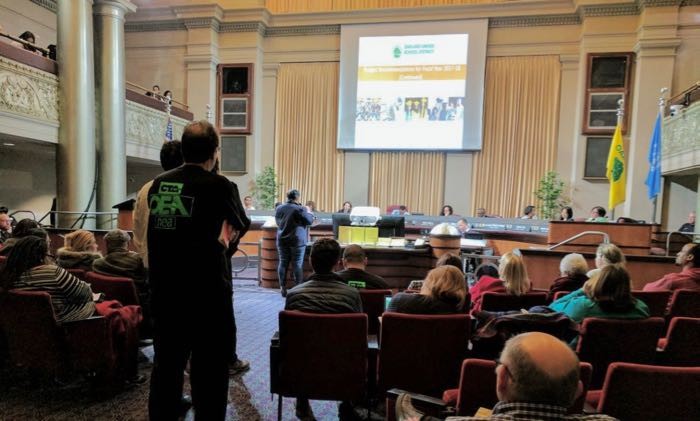School Boards Demystified

While federal and state decisions exert influence on local public schools, neither the federal government nor the state government actually run them. Local public schools are run locally. About 6 million children are enrolled in California’s public schools.
In This Post
Who governs local schools?
Who runs local schools?
Who are the members of the school board?
What are the responsibilities of a school board member?
For whom does the superintendent work?
Are all school boards the same?
Does every district have its own school board?
Are school board meetings open to the public?
Are school board members paid?
How can I influence school board decisions?
The policies and priorities for running a district’s regular public schools are set by a locally-elected school board and are implemented by district staff under the direction of the superintendent. Public charter schools, which enroll about 600,000 of those students, are also governed locally, but by a governing body not affiliated with the local school board. They are also subject to oversight by their authorizer.
Who are the people that make up the School Board?
School board members are elected to ensure that the local schools represent the values of the community.
Trustees, School Board Members, Governing Board Members – no matter what you call them, they are locally elected public officials whose job it is to govern the public schools in their community. School board members are elected to ensure that local schools represent the values of the community. They are members of the community and live in the districts where they serve.
Want to know the members of a school board, and when their term ends? It's public data, conveniently available from XQ Institute.
School Boards and Their Duties
While student outcomes are at the crux of their work, that is not all that school board members must monitor. Boards are also responsible for:
- Adopting collective bargaining agreements,
- Evaluating programs,
- Adopting and overseeing budgets,
- Approving the Local Control and Accountability Plan (LCAP), and
- The evaluation and hiring/firing of the superintendent.
The superintendent, by the way, is the Board’s only employee. The superintendent works for the School Board. All other employees work for the School District, under the superintendent's leadership.
Authority to govern is granted to the board, as a whole. No single school board member has the authority to make decisions on his/her own. Board Members work as a governance team, along with the superintendent, to make decisions that will best serve all the students in the community. Effective boards work hard to build strong relationships amongst themselves and with the superintendent.
Authority to govern is granted to the board, as a whole. No single school board member has the authority to make decisions on his/her own.
Some practices vary by district
Depending upon the size of the district, the school board will have 3, 5 or 7 members. Some districts elect board members "at-large", meaning that all board members represent the whole school district. Others elect board members who live in and represent specific areas of their district. Most board members are paid some stipend for their work, but the amount varies district by district.
Others are consistent statewide
Members of school boards serve for 4 years in staggered terms. School boards are public entities, and their meetings are subject to the requirements of the Ralph M. Brown Act (the Brown Act), California’s open meeting law. School Board meetings are held regularly. The agenda for the meetings must be published 72 hours in advance. There is time set aside on every agenda for public comment. (Want to know more? Watch this video.)
Why attend a Board Meeting?
Board members often find themselves in the untenable position of having to balance the desires of the community against the financial limitations that all public schools in California must face.
The public is welcome at school board meetings, even in times of crisis like the COVID-19 pandemic. Surprisingly, yes, people actually do show up for them, and what they say can influence board members' decisions. When things are going well, attendance at board meetings tends to be low. But when community members or employees are not happy, they can fill the room with people who have a message for the board. During collective bargaining with the local unions, for example, employees may come to board meetings to share their concerns about negotiations.
Attendance also tends to increase when members of the community want to address the board about a specific issue. The issue need not be on the agenda for the public to come and comment, because the meeting agenda includes time for public comment. Things like school closures and boundary changes always seem to elicit crowds at meetings. Rightfully so. As the board members are elected to represent the values of the community, so must they be mindful of the district’s financial health. Board members often find themselves in the difficult position of having to balance the desires of the community within the limitations of financial resources available.
This post is the first of a series about school boards. There is much more to know. This series will continue to explore the intricacies of school boards and their relevance in the national dialog that currently confounds and often scares us about the future of public education. School boards play an important role in citizen oversight of government and local control of our children’s futures. In the meantime, you might want to look up the date of your district’s next board meeting and plan on attending. You never know what you’ll learn.
 Denise Jennison joined the Ed100 team in 2017 to help readers understand California's school system with particular focus on school boards. Denise has been a member of the school board in the San Ramon Valley Unified School District since 2010. She has served as both the president and treasurer of the Contra Costa County School Boards Association as well as serving four years on the California State PTA Board of Managers. The daughter of two public school educators, Denise attended California public schools from elementary school through the University of California. All four of Denise’s sons attended and graduated from San Ramon Valley Unified School District schools. A credentialed teacher, Denise lives in Danville with her husband, dogs and occasional returning sons.
Denise Jennison joined the Ed100 team in 2017 to help readers understand California's school system with particular focus on school boards. Denise has been a member of the school board in the San Ramon Valley Unified School District since 2010. She has served as both the president and treasurer of the Contra Costa County School Boards Association as well as serving four years on the California State PTA Board of Managers. The daughter of two public school educators, Denise attended California public schools from elementary school through the University of California. All four of Denise’s sons attended and graduated from San Ramon Valley Unified School District schools. A credentialed teacher, Denise lives in Danville with her husband, dogs and occasional returning sons.Originally posted May, 2017. Updated October 2019, March 2020
Tags on this post
Brown Act Collective bargaining Leadership School board SuperintendentAll Tags
A-G requirements Absences Accountability Accreditation Achievement gap Administrators After school Algebra API Arts Assessment At-risk students Attendance Beacon links Bilingual education Bonds Brain Brown Act Budgets Bullying Burbank Business Career Carol Dweck Categorical funds Catholic schools Certification CHAMP Change Character Education Chart Charter schools Civics Class size CMOs Collective bargaining College Common core Community schools Contest Continuous Improvement Cost of education Counselors Creativity Crossword CSBA CTA Dashboard Data Dialogue District boundaries Districts Diversity Drawing DREAM Act Dyslexia EACH Early childhood Economic growth EdPrezi EdSource EdTech Education foundations Effort Election English learners Equity ESSA Ethnic studies Ethnic studies Evaluation rubric Expanded Learning Facilities Fake News Federal Federal policy Funding Gifted Graduation rates Grit Health Help Wanted History Home schools Homeless students Homework Hours of opportunity Humanities Independence Day Indignation Infrastructure Initiatives International Jargon Khan Academy Kindergarten LCAP LCFF Leaderboard Leadership Learning Litigation Lobbyists Local control Local funding Local governance Lottery Magnet schools Map Math Media Mental Health Mindfulness Mindset Myth Myths NAEP National comparisons NCLB Nutrition Pandemic Parcel taxes Parent Engagement Parent Leader Guide Parents peanut butter Pedagogy Pensions personalized Philanthropy PISA Planning Policy Politics population Poverty Preschool Prezi Private schools Prize Project-based learning Prop 13 Prop 98 Property taxes PTA Purpose of education puzzle Quality Race Rating Schools Reading Recruiting teachers Reform Religious education Religious schools Research Retaining teachers Rigor School board School choice School Climate School Closures Science Serrano vs Priest Sex Ed Site Map Sleep Social-emotional learning Song Special ed Spending SPSA Standards Strike STRS Student motivation Student voice Success Suicide Summer Superintendent Suspensions Talent Teacher pay Teacher shortage Teachers Technology Technology in education Template Test scores Tests Time in school Time on task Trump Undocumented Unions Universal education Vaccination Values Vaping Video Volunteering Volunteers Vote Vouchers Winners Year in ReviewSharing is caring!
Password Reset
Search all lesson and blog content here.
Login with Email
We will send your Login Link to your email
address. Click on the link and you will be
logged into Ed100. No more passwords to
remember!














Questions & Comments
To comment or reply, please sign in .